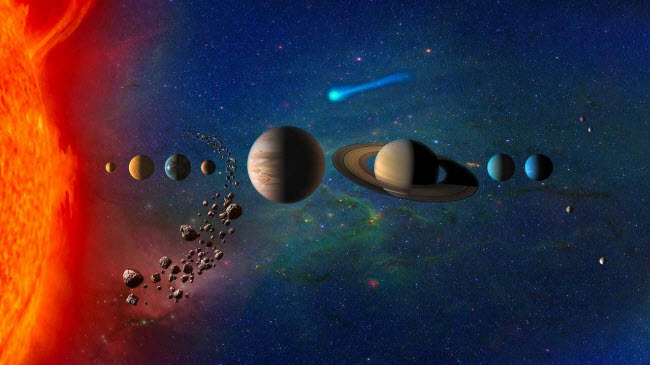Space is vast beyond imagination, and our solar system is just a tiny part of it. Despite significant advances in space science, there remains a vast amount of work to understand the mysteries of some of its phenomena, which are still elusive and strange to our understanding. In this article, we explore some of the most bizarre and unexplained cosmic phenomena observed so far.
Cyclones on Jupiter Shaped Like Honeycombs

Scientifically, cyclones are present on most planets with an atmosphere and moisture beneath their clouds, including Earth. On Earth, cyclones typically have a somewhat circular shape with an eye in the center. However, on giant gas planets like Jupiter, cyclones exhibit a unique phenomenon. Recently, scientists discovered that cyclones on Jupiter often take on hexagonal shapes resembling honeycombs around the planet’s poles. This discovery is not limited to Jupiter alone; in 1988, scientists also found a giant hexagonal cyclone at one of Saturn’s poles. While many theories have been proposed to explain these hexagonal cyclones, no definitive explanation has been confirmed.
Saturn’s Iapetus Moon Shaped Like a Walnut

Iapetus, Saturn’s third-largest moon, ranks eleventh in the order of solar system moons. It exhibits a strange phenomenon where its mountains are not scattered but form mountain ranges that can rise up to 20 kilometers along its equator—over twice the height of Mount Everest. This mountain range is responsible for the moon’s peculiar and puzzling walnut-like shape. Scientists are still uncertain why these mountains exist in this form, though some believe they may be remnants of a ring similar to Saturn’s that eventually settled on its surface. Another theory suggests that Iapetus could be made from debris of a former moon. Its unique shape is not only due to its mountains but also its half-dark, half-light coloration, making it one of the strangest objects in our solar system.
The Deformed Moon Miranda of Uranus

Miranda is one of the most unusual moons in the solar system, orbiting Uranus. Its surface is extremely rugged, covered with craters and deep valleys, giving it a patchwork appearance. Some compare it to a monster created by Frankenstein. Theories about Miranda’s deformation include catastrophic impacts like earthquakes, volcanic activity, or collisions with other celestial bodies. Uranus itself is believed to have experienced numerous impacts, which might explain Miranda’s irregular shape. Another theory posits that Uranus’s gravitational forces could have caused unusual volcanic activity on Miranda, leading to its distorted appearance.
Neptune Emitting More Heat Than It Receives

It is logical to assume that a planet far from the Sun would be very cold. For instance, Pluto, once the farthest planet in our solar system, has a warmest spot at -223°C. Since Pluto’s reclassification, Neptune is the farthest planet from the Sun, with a temperature of -200°C. Despite this, scientists find Neptune to be warmer than expected, emitting more than twice the energy it receives from the Sun. One plausible theory is that diamond rain on Neptune could be the cause. This theory suggests that Neptune’s atmospheric pressure compresses methane into diamonds, which then fall and generate heat through friction with the thick atmosphere, explaining the unusual amount of energy emitted by this icy giant.
Pluto’s Massive Nitrogen Reserves

Due to Pluto’s small size, it barely has enough gravity to retain its atmosphere. Consequently, it continuously loses hundreds of tons of its nitrogen-rich atmosphere as it orbits the Sun. This raises the question of why Pluto’s nitrogen reserves have not depleted. Scientists believe that there might be some hidden geological processes within Pluto responsible for replenishing its nitrogen. However, the exact nature of this process remains a mystery, representing one of the unexplained phenomena of the dwarf planet.
Possible Ninth Planet at the Edge of the Solar System

Despite Pluto’s exclusion from the list of solar system planets, some astronomers speculate that a ninth planet might exist in our solar system. This hypothesis arises from observed gravitational anomalies in objects within the Kuiper Belt—a region of large asteroids beyond Neptune. The gravitational irregularities might be caused by a large, undiscovered planet. However, confirming the existence of this hypothetical planet is challenging due to its distant location, making it difficult for even the most advanced telescopes to detect. If it exists, it is thought to be an icy planet about three times the size of Earth.
Methane on Mars

Although methane is found on various planets, its presence on rocky planets like Mars is particularly intriguing because it is a common byproduct of life. Scientists have detected small amounts of methane on Mars, potentially produced by seasonal changes or the absorption of the gas by the planet’s rocks. An exciting theory is that the methane variations could indicate the presence of life on Mars, likely in the form of bacteria living beneath the planet’s surface.
The Upper Atmosphere of the Sun Hotter Than Its Surface

The Sun’s surface is extremely hot, reaching about 5500°C. However, the less visible upper atmosphere, known as the corona, is much hotter, ranging from 1 to 10 million°C. This discrepancy raises the question of why the corona is so much hotter than the Sun’s surface. Scientists are uncertain but propose that tiny solar flares on the Sun’s surface could transfer energy to the corona, explaining the high temperatures.
The Solar System Itself Is Peculiar

Our solar system is characterized by its own strangeness. NASA scientists have noted that other star systems usually have planets of similar sizes moving in regular orbits, unlike our solar system, where the planets vary greatly in size. For example, Jupiter’s diameter is 28 times that of Mercury, and Jupiter is 24,000 times the size of Mercury. Additionally, the spacing between planets is irregular, which puzzles astronomers. Some theorize that the gravitational influence of Jupiter and Saturn might explain these anomalies.
